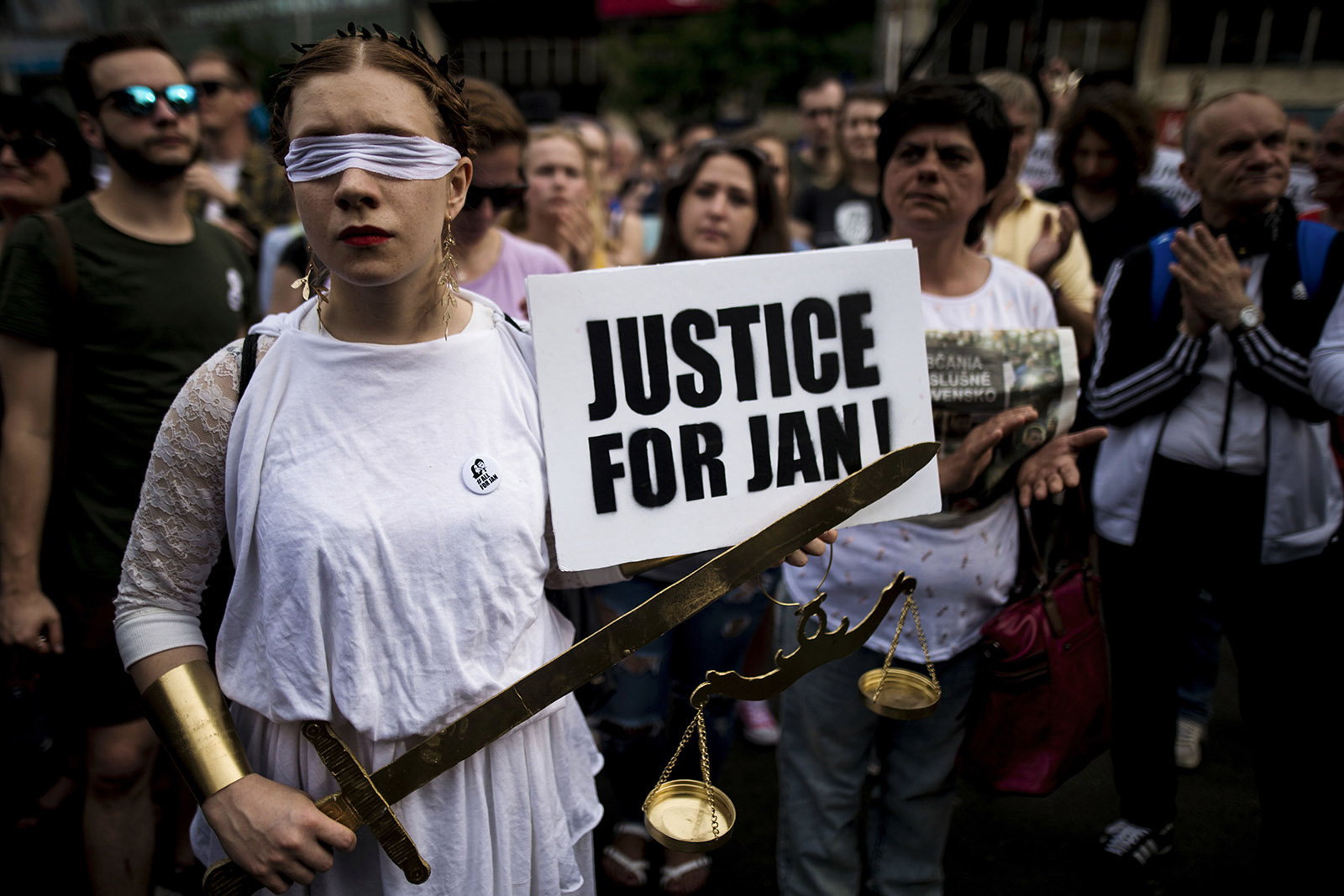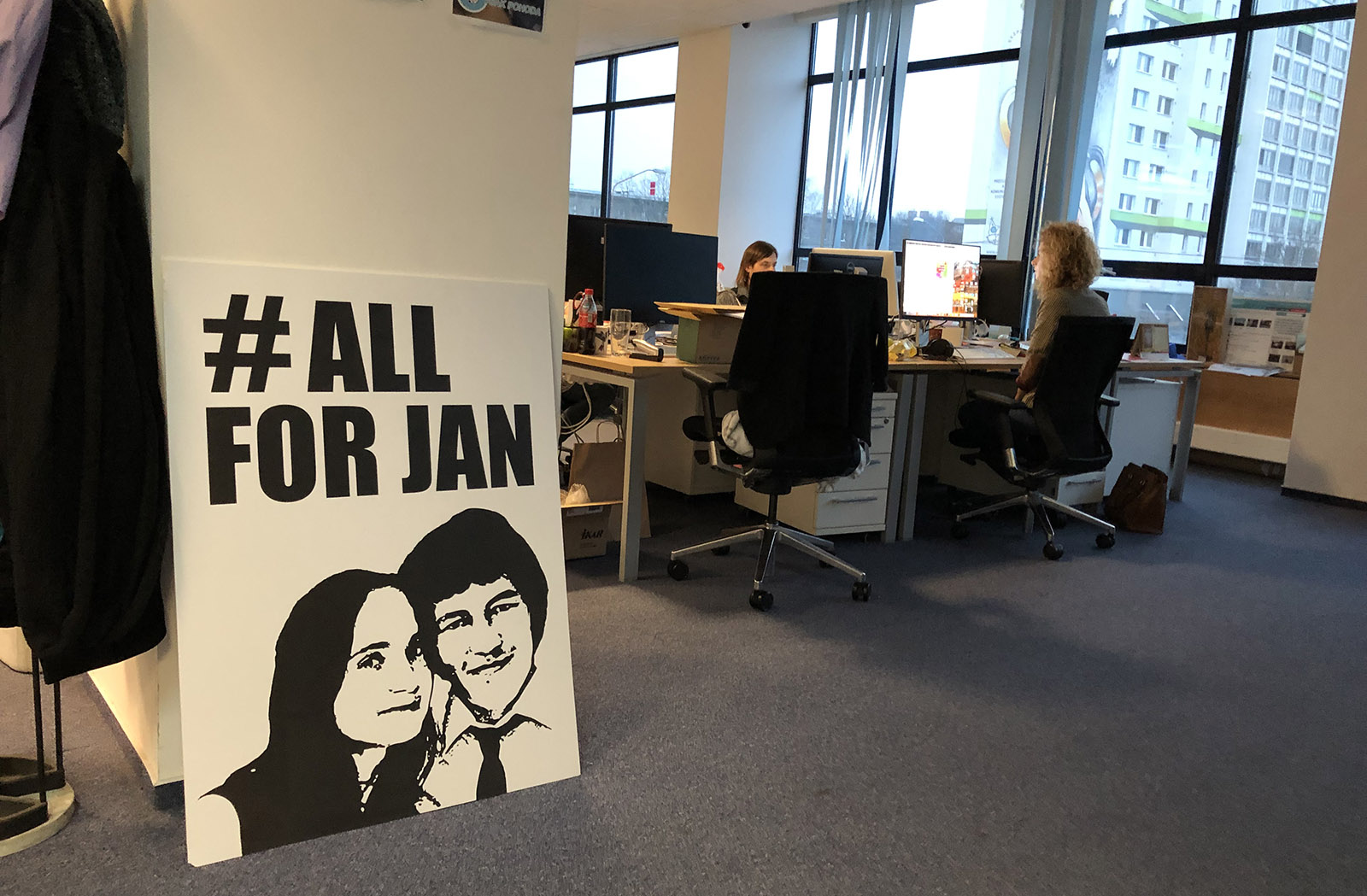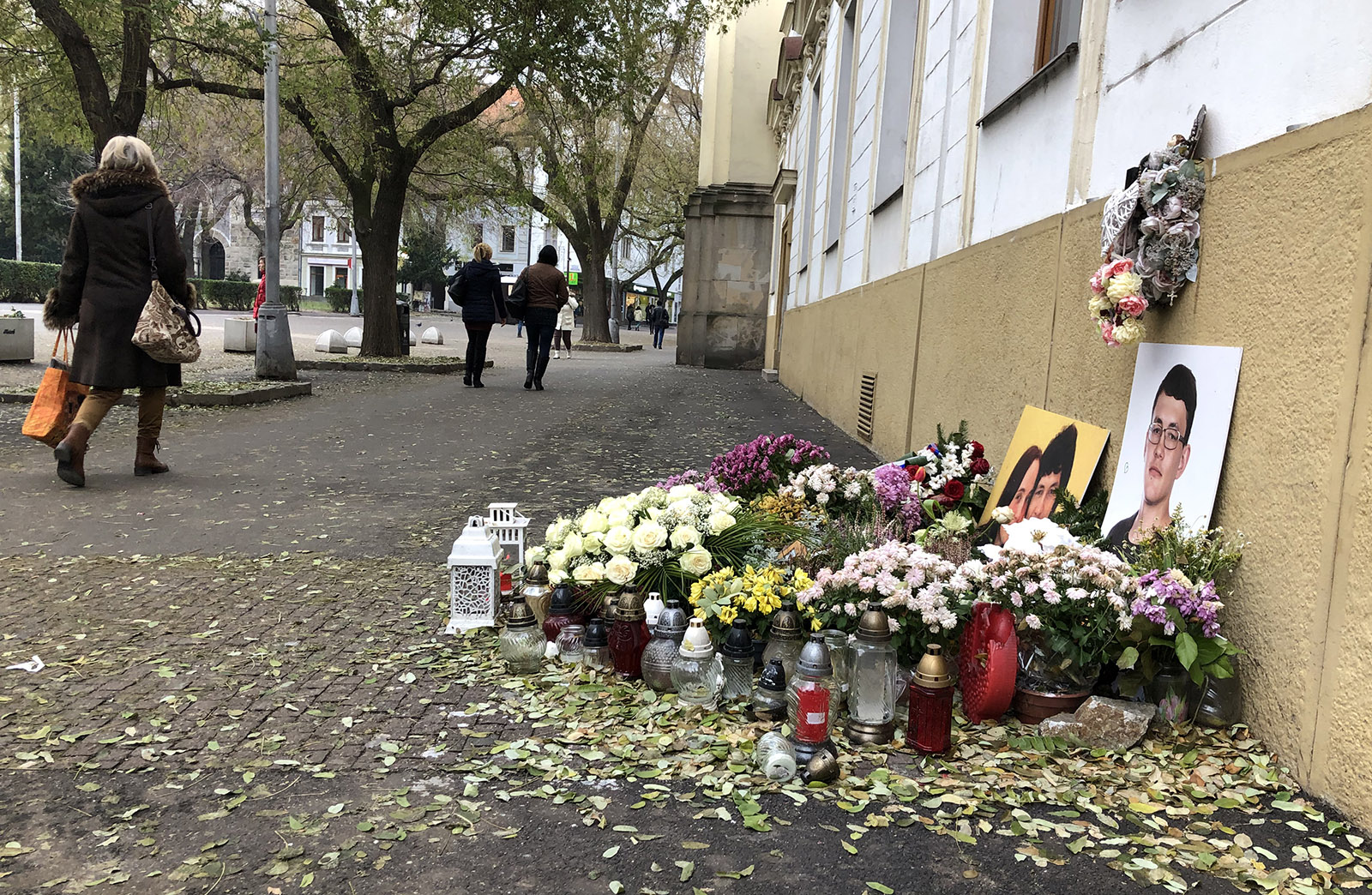Thirty miles northeast of the Slovakian capital Bratislava is Veľká Mača, a village-turned-bedroom-community of tightly packed bungalows fanning out from a big Catholic church, a small supermarket, and a smoky pub. In winter, the surrounding fields are dusted with snow, some planted with wheat but many now filled with hangar-like logistic centers for Amazon, DHL, and other markers of economic change.
Nearly a year ago, hired killers drove into this quiet town, broke into a small prefabricated bungalow, and shot dead two young people: the investigative journalist Ján Kuciak and his fiancée, Martina Kusnirova, an archaeologist at a local research institute.
Kuciak was investigating the link between senior political leaders and organized crime, and, as police investigations later made plain, this was the payback. In a region where authoritarianism is rising and press freedom is shrinking, the couple’s execution-style killing was seen as a portent of darker days to come, especially in a country long viewed as poorer and more autocratic than many of its better-known neighbors.
Over the past year, however, something unexpected happened. Instead of joining Hungary, Poland, and the Czech Republic in sliding toward authoritarianism, hundreds of thousands of Slovaks have rallied around their fragile democracy. Protesters in Bratislava and fifty cities across this country of five million staged the largest demonstrations since the Velvet Revolution of 1989. The government resigned. Reforms were passed. Journalists, some of them fierce rivals, banded together to complete some of Kuciak’s unfinished projects.
These changes may not last. Although Slovakia’s leaders have changed, their autocratically oriented government remains in control, and could win this year’s presidential and next year’s parliamentary elections. But at a time when democracy is under siege around the world, Slovakia’s spirited response is an important counterpoint, a small victory built on luck, guile, and courage.
*
When Beata Balogová was a small child in the 1970s, she spent weekdays with her grandmother in a village near the Hungarian border. Hoping to keep the young girl entertained, the older woman asked her to make a newspaper. So the five-year-old began to record recipes for jam, the names of flowers, and the sometimes fanciful stories that villagers told her.
“My image of a journalist was someone who wrote diaries like this but for a broader public,” she told me during a visit I made to Slovakia in December. “And so, from then on, I knew I wanted to be a journalist.”
Now a forty-eight-year-old redhead with piercing blue-green eyes and the intensity of a trial lawyer, Balogová runs SME, the biggest independent Slovakian newspaper. She’s known for her front-page editorials attacking the government, but also for nurturing a broad readership that goes beyond the prosperous bubble of Bratislava.
Balogová learned this balancing act at home. Her father was born days after World War II ended in 1945 and grew up in the Communist era. For his generation, the 1968 Czechoslovak uprising was a lost chance for freedom, but he gained little when Communism finally collapsed in 1989. He lost his job as a manager at an automobile factory and spent years fruitlessly looking for work. The shame of unemployment was so great that he refused to leave home and was eventually committed to an asylum, dying there at the age of sixty-two.
“He didn’t care he could watch fifty channels of shit on television,” Balogová said. “He didn’t care that suddenly, [in] the shops, he could buy anything—because he didn’t have a job. His dignity was taken away. This is the story of a whole generation.
“Today, what we’re facing is that this generation was left behind. That’s why they’re voting for nationalists or populists. They’re sick of reforms and changes. They want stability.”
*
Slovakia is an often forgotten part of Central Europe. When it was part of Czechoslovakia, the country’s name was often shortened to “Czech,” and many foreigners didn’t realize that the country’s famous reformist leader of 1968, Alexander Dubček, was Slovak, or that one of the most iconic pictures of that revolution—a man ripping open his shirt in front of the barrel of a Soviet tank—was taken in Bratislava, and not Prague, as was then widely reported. Even Western comedians couldn’t get it straight: when Steve Martin and Dan Aykroyd played “two wild and crazy guys” in several of the most famous skits Saturday Night Live in the 1970s, they parodied a couple of klutzy Czechs from… Bratislava.
Slovakia gained its independence through an inauspiciously undemocratic act, when two leaders—the Slovak Vladimír Mečiar and the Czech Václav Klaus—decided to split the country, partly because they had radically different visions. While Klaus was a Thatcherite, eager to adopt the shock therapy of privatization and market economics, Mečiar wanted to steer closer to Russia and more state control. Without a vote, Czechoslovakia ceased to exist.
Advertisement
Days after Slovakia came into existence on January 1, 1993, Mečiar’s government fired most of the critical journalists working for the country’s largest newspaper, the state-run Smena. One of them was Alexej Fulmek, a former war reporter, who joined others in founding SME.
Mečiar’s government ostracized the new publication, forbidding local presses to print it. It also refused to advertise in SME, depriving it of an important source of revenue for many newspapers in the region.
The fledgling paper, however, fought back. It received three loans to build its own presses from the Media Development Loan Fund, as the New York-based nongovernmental organization backed by George Soros and a variety of other philanthropists was then known. The presses allowed SME to stay in business and to earn outside sources of income by printing other publications. Fulmek became an editor and is now SME’s publisher.
I met Fulmek in his office in downtown Bratislava. A fifty-two-year-old with bristly gray hair and a wrestler’s build, he said that crucial to SME’s survival was that the company learned to make its own money and not rely on grants.
“They loaned us money and we paid it back early,” he said. “If you don’t make the money that you pay your staff, you’re not independent.”
Many Slovaks credit SME with helping to bring down Mečiar in 1998. Its reporting, especially on an alleged effort by Mečiar to kidnap the president’s son, shocked many people into voting out the self-proclaimed father of the Slovak nation. Under opposition rule for most of the next eight years, Slovakia moved quickly toward the West. It joined the European Union and NATO in 2004, and the eurozone in 2009.
Early on, these moves encouraged Western media companies to invest, often touting their ventures as good for press freedom. In 1999, the German media company Verlagsgruppe Passau invested in SME, buying half of SME’s shares, and later selling its stake to another German investor, Rheinisch-Bergische Verlagsgesellschaft. But in 2014, the Germans lost interest and sold to Penta, a Slovak consortium close to the government. By then, the country was led by Robert Fico, a nascent authoritarian leader who was implicated in several corruption scandals, including one involving one of Penta’s partners, Jaroslav Haščák.
This violated what Fulmek said had been an informal agreement that the Germans would not sell to an oligarch. (The Germans said they were not selling to Penta, which was technically correct, but the buyer was, in fact, an intermediary for the consortium.) Suddenly, Penta owned half of SME’s parent company and Slovakia’s most important newspaper seemed about to undergo the sort of Gleichschaltung that scholars had identified occurring across the region: the shift in media ownership from local control around 1990 to international control in the 2000s and now to oligarch control, a dangerous step toward the crushing of a free press and the shrinking of democracy.
“It was not very nice—an ugly thing,” Fulmek told me, of this betrayal. “In the past, people thought Western owners were good.”
The move demoralized the staff and SME began hemorrhaging top reporters and editors. Fulmek made two crucial decisions. First, he told Penta that he and the rest of the staff would join the others in leaving if Penta didn’t sell a controlling 5 percent portion of the company’s shares to a consortium of local investors who supported the newspaper’s critical reporting. Faced with their new asset’s potential self-destruction, Penta agreed and Fulmek’s team regained their independence. (Later, local investors bought another 11 percent from Penta, which maintains a stake of 36 percent.)
To prove he really had control, Fulmek turned to Balogová. At the time, she was running one of the parent company’s English-language monthlies and had a strong reputation for independence. She had studied journalism twice in the United States—during a Fulbright fellowship at the University of Missouri in the early 1990s, and later earning master’s degree at Columbia University.
“She was needed to stabilize the ship,” Fulmek said. “She had the credibility.”
By early 2015, Slovakia was in an enviable position. Its most influential newspaper was independent, and the turmoil had created the conditions for other feisty media organizations to spring up.
One was a publication set up by the reporters who had left SME and the other was Aktuality, an online tabloid magazine that its foreign owners—Germany’s Axel Springer AG and Switzerland’s Ringier AG—decided in the wake of the SME crisis to make a bit more serious by hiring a team of journalists. So, in mid-2015, its editor, Peter Bárdy, moved Aktuality’s office from a town in the east of the country to Bratislava and hired twenty reporters and editors, including a small team of investigative journalists.
Advertisement
One of Bárdy’s first hires was Ján Kuciak, a twenty-five year-old who had just graduated from journalism school after working as a lumberjack. Quiet, devoutly Catholic, and constantly in good spirits, Kuciak was one of Bárdy’s favorites.
“He was genuinely nice,” Bárdy told me during a talk in his offices. “I don’t know how to put it—he was like the scene at the start of The Matrix with the numbers coming down on the screen. He could sit in front of the computer and see patterns.”
Kuciak’s biggest story was his last. He began to notice that the Italian mafia had moved into Slovakia, especially to the country’s economically struggling regions that lie east of Bratislava. The mafia seemed to be engaging in weapons-smuggling to Italy. That was interesting enough, but Kuciak delved further. Using freedom of information laws, he obtained documents showing that one of the mafia figures had close ties to a senior official of the country’s security council, as well as to a former Miss Universe contestant who worked on the staff of Prime Minister Fico. But before he could complete the story, Kuciak and his fiancée were shot to death.
Shocked and revolted, half a dozen young Slovaks in their twenties and thirties set up the Movement for a Decent Slovakia. A few days after the murders, they called for a protest wake in downtown Bratislava. Forty thousand people attended, including the reform-minded president, Andrej Kiska. Fico railed against supposed foreign forces using Kuciak’s death for their own purposes, but the organizers were genuine political novices without outside ties, making it hard for Fico’s slander to stick.
It helped, too, that Kuciak made a near-perfect martyr. He was a devout churchgoer, and his home was modest. The Catholic Church itself, some of whose high-ranking clergy twenty years earlier had lauded the authoritarian Mečiar, gave its approval to the demonstration.
The protesters set up a group called We Want to Trust and asked for help from veteran members of Slovakia’s NGO scene, including Zuzana Števulová, a thirty-five-year-old activist for migrant rights. Their advice was to ensure that the movement stayed nonviolent and focused on reforms connected with Kuciak’s murder, such as to the legal system.
“Ján’s murder made a part of society wake up,” Števulová told me. “They realized that something was happening—that we had allowed oligarchs to run the country.”
The reason Slovakia hasn’t gone the way of Hungary, Števulová believes, is two-fold. One is that civil society is still credited with having brought down Meciar in 1998. This made its institutions harder to attack as part of a foreign plot. The other reason, she said, is that enough of the press is still independent.
“We still have a lot of conspiracy theorists. Society is still polarized,” she said. “But it’s not part of the mainstream media.”
That is reflected in the Slovakian news media’s reach. The news site Aktuality.sk reaches 550,000 unique viewers a day, about the same as SME’s online audience. Together, even allowing for overlap, that’s an estimated 750,000 people, while SME’s print run of 34,000 reaches another significant group. Considering Slovakia’s population of 5 million, that’s a large percentage of the adult population.
Balogová and others, though, are still not convinced that Slovakia has succeeded in shrugging off the menace of oligarchy. An ethnic Hungarian, Balogová pays particularly close attention to her country’s neighbors. In the Czech Republic and Hungary, mass demonstrations have also taken place, but little has changed. That’s partly due to oligarchic control of the media, but also because people seem tired of this new era of uncertainty and have settled for stability.
“Hungary is where it is because Orbán has spent ten years undermining the system,” she said. “He shows that you can do it by playing by the rules.”
I told Balogová about my trip out to see Kuciak’s home in Vel’ká Mača. I’d rented a car and driven around the town until I found the house, a pathetic little box of cracked stucco, surrounded by a wall with a rusted gate. People had built a little shrine of candles, flowers, and photos, and someone had spray-painted the gate with bright yellow words. I showed Balogová a photo of the scene and she smiled, reading the words out loud.
“‘Love conquers evil,’” she said slowly, considering the proposition. “I don’t know. Maybe. Hopefully.”





